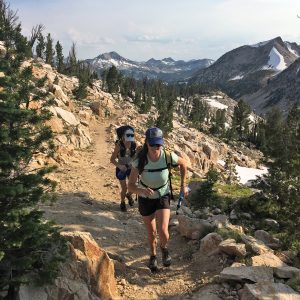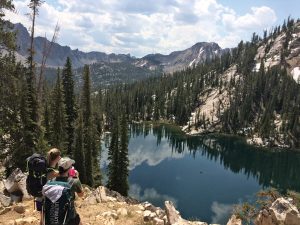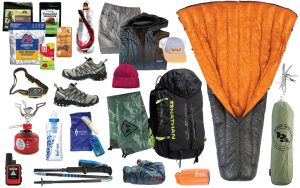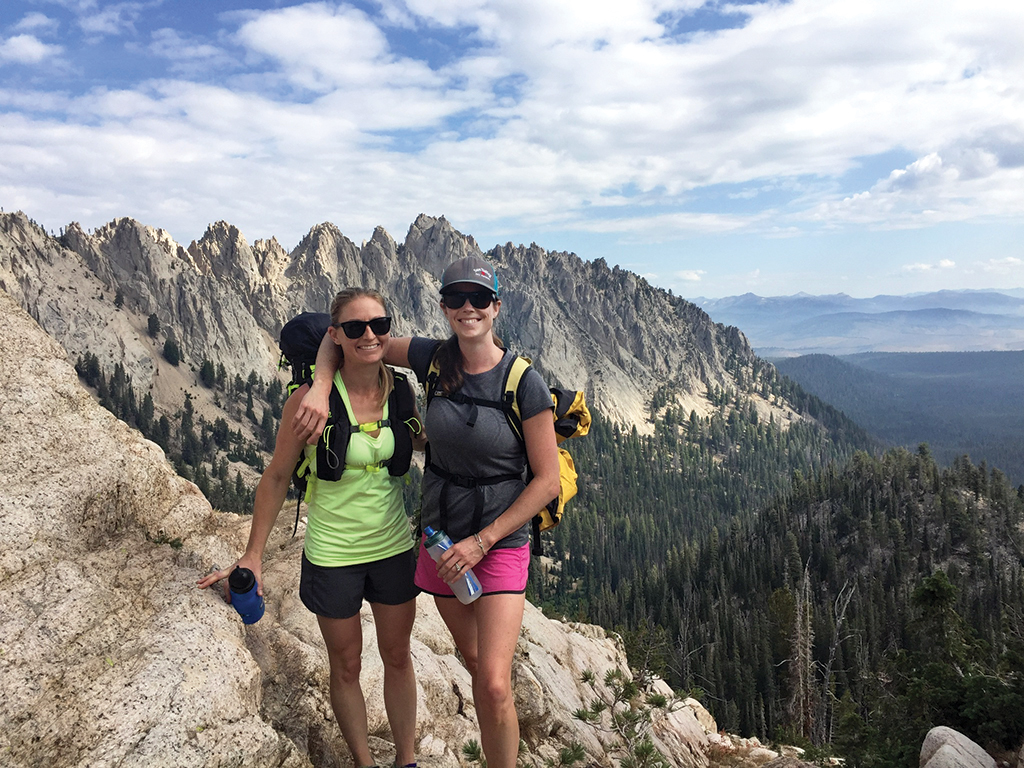While to some the fusion of trail running and ultralight backpacking known as “fastpacking” means slimming down to rationed energy chews and freeze-dried meals, to Wood River Valley locals Kat Bridwell, Erin Resko Hill and Ashley Brown, there are some nonnegotiables: chocolate, cheese, salami, and wine.
The three women grew up in Hailey, playing together since they were little, shredding side by side as teenagers through local teams on the soccer field and on the ski hill, engaging in countless adventures from river trips to ski trips, and as bridesmaids in each other’s weddings. For many who grow up here, it’s hard not to gravitate home, and Bridwell, Hill and Brown all made their way back to the Wood River Valley after various stints living elsewhere.
Now, Bridwell is an engineer, Brown is a physician’s assistant, and Hill is a kettlebell instructor and owns her own business Erin Hill Acupuncture—she also has nine goats that she and her husband use as a pack-goat business (the goats keep their 13 chickens company). In Bridwell’s words, “Erin [Hill] is the mother of goats and perhaps the world’s cutest baby, Zoe Hawkens Resko Hill; Ashley [Brown] is the mother to the world’s cutest newborn, Penelope May Tautkus and world-famous Lab Chunk; and I am the mother of ‘dragons’ Darlene, Dorothy and Edna.”
After hearing about locals Lisa Scales and Megan Stevenson fastpacking the Middle Fork of the Salmon River, Bridwell, Hill and Brown were inspired to put together a fastpacking trip of their own. “There are much more hardcore people in the valley doing much longer and faster fastpacking trips,” noted Brown. “We didn’t want to rough it,” she added. “Our first trip was really enjoyable, and once we did it, we quickly realized how easy it was to put together.”

A simple structure, using a telescoping hiking pole, provides shelter for the night.
For their first run, the ladies ran “24 miles, but maybe it could have been 30” through the Sawtooths, swimming in lakes along the way. Their one hard goal was to make it to Redfish Lake in time for the noon boat shuttle to be drinking a celebratory cocktail at Redfish Lake Lodge by 1 p.m. They ran 75 percent of the run the first day, jogging and taking breaks for snacks and swims. Over those afternoon cocktails at Redfish the next day, they immediately began planning their next fastpack trip.
The differentiation between backpacking and fastpacking is the superlight gear that’s made to be comfortable and compact so you can run long distances while carrying it. For the two-day trip, Hill, Brown, and Bridwell’s packs each weighed 12-14 pounds, fully loaded (compare that to a traditional backpack, which might weigh anywhere from 30-45 pounds or more for a similar trip).
“The fastpack backpacks are really awesome,” described Hill when asked about the details of what they carried. “They sit perfectly on your back and don’t bounce, and that made all the difference. It felt like you were just running with a CamelBak on.”

On the trail to Sawtooth Lake.
In their packs, the team each had a lightweight sleeping quilt, a little pad of some kind, extra clothing (shorts, socks, shirt, and a bra, just in case), a Sawyer filter (which is like a LifeStraw) that allows you to just scoop water out of the streams and drink, snacks, dehydrated meals, and the nonnegotiable wine, cheese, salami, and chocolate. They divided up team gear, which included hiking poles to use in case someone got hurt and to prop up their shelter—a light rain tarp to sleep under and a footprint tarp to sleep on, a small stove with a fuel canister that fits in the palm of your hand, a little pot, and a device to contact someone in case of an emergency.
Brown described, “We kept passing people with what looked like 80-pound packs, and all I could think was: Oh my god, we are all going to have the same experience, but I am not carrying 80 pounds. I am never backpacking like that again.”

The view from Alpine Lake on the first day of their fastpacking adventure.
Hill smiled, “My biggest takeaway was that we were surprised by how fun and easy it turned out to be. I always get cold and freezing at night so that was my biggest concern, but it wasn’t that bad at all, especially all sleeping cozied in next to each other.” She continued, “It’s not that different than overnight backpacking. You’re moving all day anyway and we weren’t running hard. We made it fun, jogged along and chatted, took breaks for snacks, and walked if we needed … in those mountains, there are some pretty big uphills. Really, anybody can move all day and that’s all fastpacking is. It’s just fun and I can’t wait for the next one!”
Upon looking at the weather for their second fastpack trip in the fall, Bridwell, Hill, and Brown also threw in rain jackets, and a warm layer and hat, which turned out to be key additions. Their second route took them a little more “in the middle of nowhere” than the first one. After a long first day of somewhere between “18 and 26 miles” and quite a bit of vertical, Brown, Hill and Bridwell hit their planned camp and threw up their hiking pole-propped rain tarp just in time for an instant downpour and crashing thunderstorm. The team cozied up in their shelter, knowing every extra pound of cheese, sausage, and the small plastic bottle filled with wine they brought, was worth the weight.

The Perfect Pack
Look for lightweight packs of 30L or less that fit closely to the body (to prevent bouncing while running). Bouncing leads to pressure points and chafing over time (hot spots), so this is essential. Paddy McIlvoy from Backwoods Mountain Sports in Ketchum recommends looking for mesh harness systems, which help wick sweat and tend to hug more closely to your body.
ITEMS TO CONSIDER:
1. Emergency Communication Device — not essential, but good for peace of mind in case of injury or other emergencies. Spot and Garmin both make compact, lightweight and, most importantly, reliable models that work in the backcountry.
2. Telescoping hiking poles — essential in case of injury or for descending steep terrain, also doubles as a way to prop up a sleep shelter or rain tarp.
3. Hydration — a Sawyer filer or LifeStraw, to allow filtering water directly from lakes and streams along the trail. Hydration is key at elevation! RapidPure and Katadyn are tried and true brands.
4. Food — a mini stove that allows for hot meals and drinks should temperatures drop, or just to guarantee that essential cup of morning coffee. MSR and JetBoil make micro systems that fit in the palm of your hand and weigh almost nothing.
5. Clothing — both a lightweight rain jacket (for both rain and wind) and extra set of dry clothing are key. A wool beanie and headlamp help with meal prep and nighttime temperature drops. Invest in a good pair of socks—you don’t want blisters!
6. Sleeping Gear — a shelter system or footprint tarp to sleep on and rain tarp to sleep under, lightweight sleeping quilt, a small pad of some kind. Thermarest makes an ultralight sleeping pad, the Neoair® Uberlite™, that weighs less than 9 ounces
and packs down to 20 x 72 inches.


